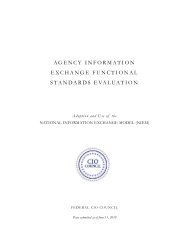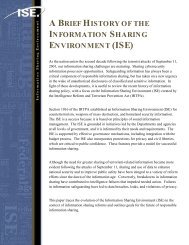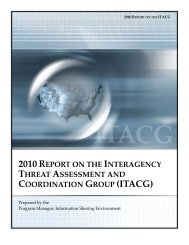ITACG Intelligence Guide for First Responders 2nd Edition - ISE.gov
ITACG Intelligence Guide for First Responders 2nd Edition - ISE.gov
ITACG Intelligence Guide for First Responders 2nd Edition - ISE.gov
Create successful ePaper yourself
Turn your PDF publications into a flip-book with our unique Google optimized e-Paper software.
What is a SAR and why is it important?<br />
Law en<strong>for</strong>cement entities carry out counterterrorism-related activities as part of their duty<br />
to protect local communities from crime and violence. It is important that first responders<br />
who recognize criminal behaviors and incidents associated with the planning and carrying<br />
out of a terrorist attack document and share this in<strong>for</strong>mation via a SAR.<br />
The SAR Process<br />
All agencies, regardless of size or jurisdiction, have a role in the nationwide SAR process. It is<br />
essential that state, local, tribal, and federal agencies establish standardized SAR programs<br />
and work together to share SAR in<strong>for</strong>mation in order to prevent and deter terrorist attacks<br />
on American soil. There are five basic cornerstones to implementing the SAR process:<br />
75<br />
intelligence guide <strong>for</strong> first responders - <strong>2nd</strong> edition | how to<br />
• Stakeholder management - Knowing, understanding, and communicating with all<br />
stakeholders is key to success. The chief executive and agency leadership must recognize<br />
the importance of implementing a SAR process within their agency and champion the<br />
ef<strong>for</strong>ts of the SAR process and the NSI both inside and outside the agency. Outreach<br />
to the community is being done through an initiative called, Building Communities<br />
of Trust and is also being done in collaboration with the “If you see something,<br />
say something” campaign launched by the Department of Homeland Security in<br />
July 2010.<br />
• Training – The NSI training strategy is a multifaceted approach designed to increase<br />
the effectiveness of state, local, and tribal law en<strong>for</strong>cement professionals in<br />
identifying, reporting, evaluating, and sharing pre-incident terrorism indicators to<br />
prevent acts of terrorism. The overarching goal of the training strategy is to facilitate<br />
agency implementation of the SAR process, ensure the inclusion of civil rights, civil<br />
liberties and privacy safeguards, and to enhance a nationwide SAR capability. There
















